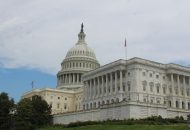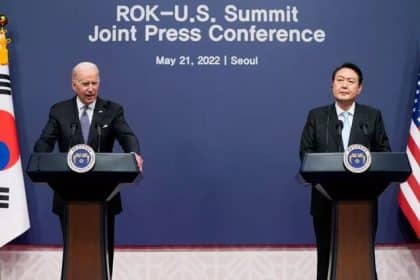Joe Manchin: Climate Hawk
COMMENTARY | The Ecomodernist

The clean energy spending in the recently unveiled Inflation Reduction Act marks a victory for the sort of bottom-up, incrementalist, behind-the-scenes climate policy that progressive climate advocates have decried as inadequate for over a decade.
It is a credit to the climate left’s pragmatism that the community ultimately championed this package of “neoliberal” tax credits and “all-of-the-above” energy subsidies that reward clean energy and fossil fuel interests alike. But in their celebration, climate hawks may be overestimating their own role in producing this legislation while underestimating the role of its most committed architect: Democratic West Virginia Sen. Joe Manchin.
The real-time claim is that the IRA represents a come-from-behind victory for the climate progressives. The bill is “a historic achievement for the climate left and a tribute to both its moral fervor and its political realism,” wrote The New York Times’ David Wallace-Wells last week. But the style of climate spending included in the IRA has always been broadly popular; Manchin himself has voiced strong support for clean energy tax credits and infrastructure spending throughout the negotiations.
The IRA, after all, strongly resembles the package of climate spending that Manchin committed to supporting in a document he co-signed with Majority Leader Chuck Schumer, D-N.Y., over a year ago, and the $1.8 trillion proposal he reportedly offered the White House in December 2021. The bill is a kind of supercharged version of what was once called the Murkowski-Manchin bill, a package of clean energy spending that Democrats killed in early 2020 that was mostly revitalized in an omnibus spending bill passed in the final weeks of the Trump administration.
It is bigger and stronger and more assertive, but unequivocally in the same lineage, as the technology R&D, tax credits and loan guarantees advanced by the 2009 American Recovery and Reinvestment Act, the Energy Policy Acts of 2005 and 1992, and countless other “quiet” climate policy vehicles passed over the last several decades. If anything distinguishes the IRA from its legislative ancestors, it is that this newest bill “says the quiet part out loud,” in that it capitalizes on a post-COVID federal willingness to direct that new spending towards strategically valuable investments in innovation and infrastructure.
Let’s peek under the hood. In addition to setting a corporate minimum tax of 15%, extending Obamacare health subsidies and some other provisions, the IRA outlays $369 billion for “energy security and climate change.” Within this large sum are $40 billion in tax credits for manufacturing, $30 billion for low-carbon agriculture R&D, extended consumer tax credits for purchasing electric vehicles, and hundreds of billions for expanded and streamlined deployment subsidies for solar, wind, geothermal, nuclear, carbon removal and other low-carbon energy technologies. It also increases federal statutory leasing targets for oil and gas projects.
What’s conspicuously missing from all of this are any of the top-line priorities that the climate left has advanced in recent years. This is not a $16 trillion program to fundamentally remake the nation’s energy, transportation and agricultural systems. There is no green jobs corps, job guarantee, universal basic income, or any of the provisions variously appended to the strategically capacious Green New Deal. There is no nationalization of the electricity or transportation sectors. There is no prohibition of Federal Reserve liquidity support for the fossil fuel sector. There is no clean electricity standard or Clean Electricity Performance Program. There is no ban on oil and gas leasing on federal lands or elsewhere. There is no federally declared climate emergency.
These proposals’ conspicuous absence should not suggest that they necessarily have no substantive merit. But climate advocates have framed the above as the defining characteristics of ambitious climate policy, the radical vision that has pushed the Overton window to the left. In reality, they are more a phantasmagoria of climate action, hypothesized and celebrated within the tight bubble of hard-line climate hawks with little purchase or influence outside of it.
If there are defining characteristics of ambitious climate policy, surely one of them is the ability to make it through Congress and attract sustained political support. And if that is the case, then the better standard bearer for climate ambition is not Extinction Rebellion or the Sunrise Movement, but Manchin himself.
Manchin has continuously supported perennially popular policy ideas like tax credits for renewable energy and jobs programs for displaced coal workers, up to and including this, “the most significant climate policy in American history,” while eschewing politically underwater proposals like the Green New Deal and emissions cap-and-trade systems. In so doing, he is one of the only politicians in America who has seen his approval ratings rise over the last several years.
Perhaps the climate movement, through its advocacy, was responsible for the size and scope of the IRA, having strategically capitalized on the technology focused instruments that Manchin and his ilk support and supersized them through popular organizing? Again, there is reason to question this description of events.
Put aside the fact that climate organizers have mostly emphasized top-down, sweeping policy tools like the Green New Deal or bans on the fossil energy infrastructure. The movement has long de-emphasized “technocratic,” “neoliberal,” “incrementalist” policy approaches typified by the IRA. Much of the climate advocacy community has asserted that it is too late to pursue an innovation-oriented agenda and rejected investments in nuclear energy, carbon removal, hydrogen and other speculative low-carbon energy technologies included in IRA. And in so doing, there is little evidence that the climate movement has rallied widespread public support for their agenda: Only about 1% of voters rank climate change as the most important issue facing the country.
Yet neither this lack of popular support, nor the enduring objections to a technologically focused, all-of-the-above climate policy, have prevented the Sierra Club, the Natural Resources Defense Council, Evergreen Action, the Sunrise Movement or most other mainstream climate organizations from enthusiastically endorsing the IRA. Again, this is to their credit. But it does somewhat beg the question of who is driving the climate policy agenda, the climate movement or the Joe Manchins of the world?
Surely, to a degree, it’s both. But the movement that in prominent corners has labeled Manchin a “coal baron” and charged him with the destruction of the planet does need to reckon with the reasons it must share credit with him.
Manchin is the deciding vote on policy approved by the United States Congress, a role at the moment personified by him, but that will always be occupied by a person or coalition more aligned with the median American voter while less aligned with the median climate advocate. Crafting ambitious, effective agendas requires emphasizing policies with broad popular appeal and material incentive for the figures on the margins of your political movement. And make no mistake, it is Manchin, a pro-union, trilliondollar-spending senator from a state that Donald Trump won by 39 points in 2020, not purportedly underdog progressive climate hawks, who is at the margin of the Democratic coalition. Notably, Manchin appears to be the driving force behind siting/permitting regulatory reform in Washington right now, reform that will be absolutely essential to building clean energy infrastructure on anything resembling a reasonable time frame.
Genuine ambition on climate change requires policy that can actually get enacted. Not for the first time, Manchin is the key figure enacting this policy. It is quite reasonable to lament that this legislation is imperfect and that the task of confronting climate change is unfinished. But in pursuit of its next iteration, we should remember not just the vision and organizing of the climate movement but the popularity and pragmatism of Joe Manchin.
Alex Trembath is the deputy director at the Breakthrough Institute, and is the lead or co-author of several Breakthrough publications, including “Saying the Quiet Part Out Loud,” “Beyond Boom and Bust” and “Our High-Energy Planet.” Follow Alex on Twitter @atrembath.
























